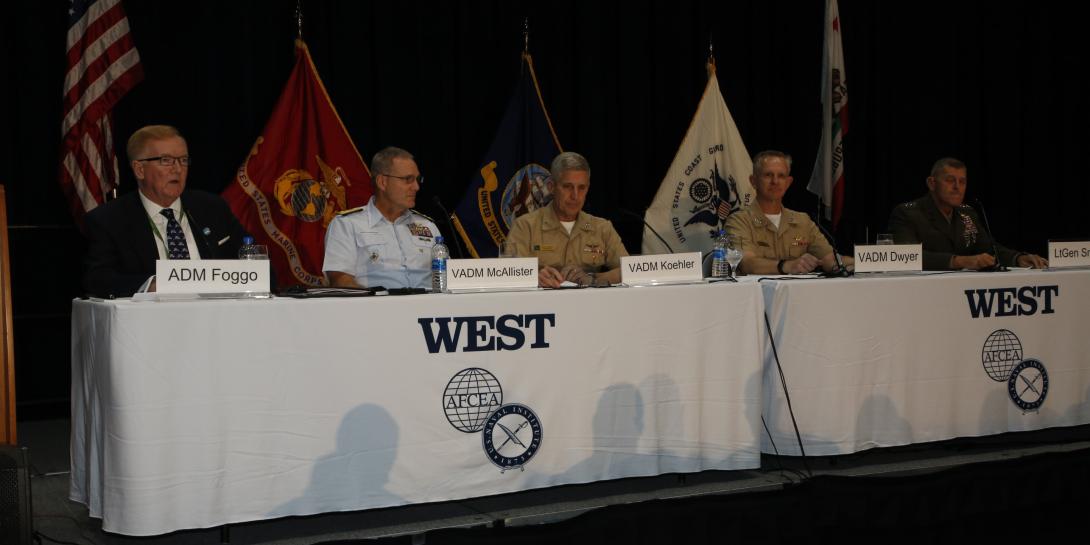Sea Services Look to Plug Gaps in Performance, Capability
The U.S. Navy, Marine Corps and Coast Guard are looking at different but sometimes complementary needs as they gird to meet new challenges. Success may rely on abandoning old ways of operation along with incorporating new technologies, said leaders from the three services.
A panel that featured two numbered fleet commanders, a Coast Guard area commander and a Marine commanding general delved into some of those requirements at WEST 2022, the conference and exposition hosted by AFCEA International and the U.S. Naval Institute in San Diego February 16-18. While some needs were well known, less obvious were the changes that need to be made in operations to support these new capabilities.
Vice Adm. Stephen T. Koehler, USN, commander, Third Fleet, called for improved long-range fires. “We have to continually morph and improve on the entire kill chain,” he declared, adding that the “assess piece” also needs attention.
“I have no desire to go into a fair fight,” Adm. Koehler warranted. “I expect to beat them soundly and decisively.”
I have no desire to go into a fair fight. I expect to beat them soundly and decisively.— Vice Adm. Stephen T. Koehler, USN, commander, Third Fleet #WEST2022
— Bob Ackerman (@rkackerman) February 16, 2022
One of those potential adversaries is China, and panel moderator Adm. James G. Foggo III, USN (Ret.), dean, Center for Maritime Strategy, described a potential threat. China continues to antagonize Taiwan, he observed, adding that some predictions call for China to move on Taiwan by 2027. The Middle Kingdom has made great strides in hypersonics and artificial intelligence, he noted.
China has made great strides in hypersonics and artificial intelligence.—Adm. James G. Foggo III, USN (Ret.), dean, Center for Maritime Strategy @Admiral_Foggo #WEST2020
— Bob Ackerman (@rkackerman) February 16, 2022
Vice Adm. Michael F. McAllister, USCG, commander, Pacific Area, and commander, Coast Guard Defense Force West, added his own warning about China. “The Chinese now have the largest coast guard in the world, and they don’t use their coast guard for the common good,” he said. The Indo-Pacific Strategy released on Friday reflects what the U.S. Coast Guard wants to do there, he noted, although he cautioned that responding to China will require more than conventional military moves. “China could march all the way around the world to South America,” he said. “We need to focus below the level of combat to stop that.”
The Chinese now have the largest coast guard in the world, and they don’t use their Coast Guard for the common good.—Vice Adm. Michael F. McAllister, USCG, commander, Pacific Area and commander, Coast Guard Defense Force West #WEST2022
— Bob Ackerman (@rkackerman) February 16, 2022
Vice Adm. Daniel W. Dwyer, USN, commander, Second Fleet, and commander, Joint Forces Command Norfolk, pointed out that, “We in the Second Fleet need to be forward to provide effective command and control of maritime forces—not just naval forces, maritime forces.” Adm. Dwyer emphasized that mixing and matching may be the way of warfare as adversaries take on U.S. forces in diverse locations.
“The potential adversary I face in the high north might be the same adversary faced by Third Fleet and Seventh Fleet,” he noted. “Adversaries see us as a joint force.”
The potential adversary I face in the high north might be the same adversary faced by third Fleet and Seventh Fleet. Adversaries see us as a joint force.—Vice Adm. Daniel W. Dwyer, USN, commander, Second Fleet and commander, Joint Forces Command Norfolk #WEST2022
— Bob Ackerman (@rkackerman) February 16, 2022
Lt. Gen. George W. Smith Jr., USMC, commanding general, 1 Marine Expeditionary Force, struck a different tone with his top priority. “We’re not placing enough emphasis on logistics, particularly logistics in a distributed contested maritime environment,” the general stated, noting, “Logistics is the pacing function in the Pacific.” Part of the problem is that exercises and war games never last long enough to test logistics, he added. Adm. Foggo agreed and added the notion that logistics is the sixth domain of warfighting.
This is all about being able to generate the virtues of mass without the vulnerabilities of concentration.—Lt. Gen. George W. Smith Jr., USMC, commanding general, 1 Marine Expeditionary Force @1stMEF #WEST2022
— Bob Ackerman (@rkackerman) February 16, 2022
Ultimately, Gen. Smith may have struck home at the heart of the issue. “This is all about being able to generate the virtues of mass without the vulnerabilities of concentration,” he declared.





Comments